
strengthen far north the


strengthen far north the


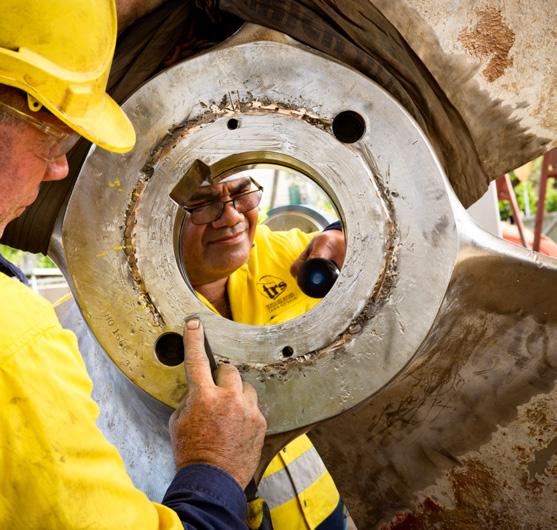



3.

Tropical North Queensland, the most populous region in Northern Australia and boasting one of the most diverse regional economies nationwide, continues to play an out-sized role in contributing to the prosperity of Queensland.
With the Queensland State Election just a few short weeks away, Advance Cairns has come together with our members and regional stakeholders to highlight key regional priorities which we believe will collectively build a more sustainable and robust future for the region.
No region in Australia is more internationally connected than Cairns and Tropical North Queensland; our geographic proximity and unique connections to the Asia Pacific and beyond are what truly makes Cairns Australia’s most global regional city1.
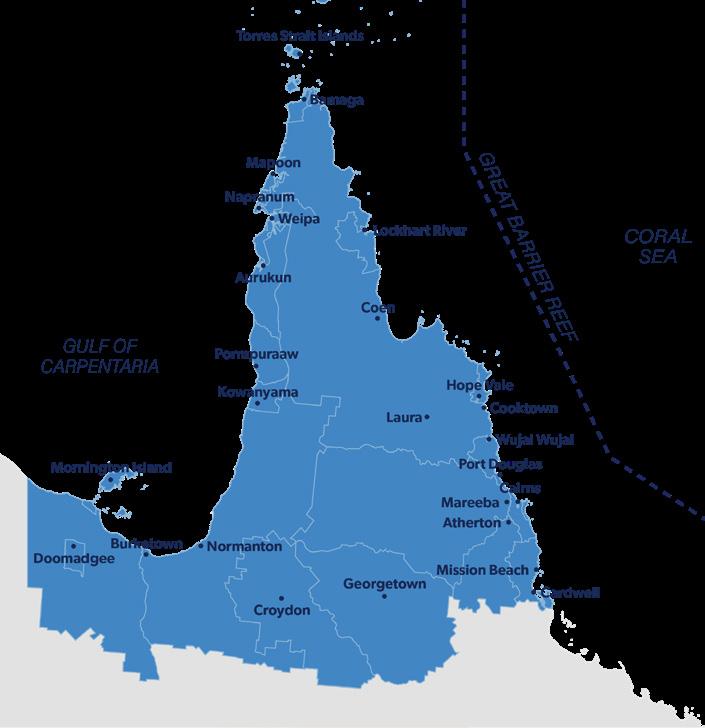
It is this proximity which provides the opportunity to capitalise on our world class produce and exports as well as advances in aviation technology, further deepening and strengthening these international connections.
Tropical North Queensland’s unique advantages brings with it increasing population pressures requiring strategic investments into health, regional connectivity and food, water, and housing security that will sustain us to 2034 and beyond.
The priorities outlined in this document, enable the region to enhance its liveability, sustain a growing population and foster economic growth while continuing to play host to millions of national and international tourists. By 2032, the region will require an additional 65,000 beds to provide for tourists alone. And tourists and residents alike depend on secure and safe water supply, reliable connectivity and access to health services.
The recent record-breaking flooding highlighted the vulnerability of the region from an infrastructure and transport perspective. How we invest and plan for our future is critical to ensure a prosperous, climate resilient future.
These priorities, supported by government, will be fundamental in delivering a prosperous future for the Tropical North Queensland region.
Many thanks in advance for your consideration of this document.
1. Bernard Salt, 2019
2. Economy.id, Population, Cairns Regional Council, last updated June 30, 2023, https://profile.id.com.au/cairns/population
3. Economy.id, Population, Far North Queensland Regional Organisation of Councils, last updated June 30, 2023, https://economy.id.com.au/fnqroc/population
Tropical North Queensland covers a vast and economically diverse area of 380,000km2, slightly larger than the size of Japan, and impacting a population of over 280,000 people. The region stretches from Cardwell in the south to the Torres Strait in the north, and west to the Northern Territory border. It is Queensland’s largest region, covering over 20% of the state and 26 local government areas.
175.4K
289.9K
$19.81B
380,000km2
Advance Cairns readily acknowledges and thanks the Queensland Government for its ongoing support for Far North Queensland and its commitment to drive growth, resilience and diversity throughout the regional economy. Support for these transformational projects below is evidence of this and we look forward to continuing to work with the government to ensure timely delivery of these projects to bolster the future prosperity of Far North Queensland.

The Cairns Marine Precinct continues to face increased demand both domestically and globally. The new $360m (50:50) Common User Facility (CUF) is set to increase much needed capacity and capability throughout the precinct, enabling the region to deliver on future defence and maritime industry business. The CUF includes a 5000-tonne shiplift, two blast and paint facilities, additional wet berth capacity and three hardstand areas for vessels up to 120m in length, securing Cairns’ position as a leading maritime MRO destination.
$180M
QUEENSLAND GOVERNMENT CONTRIBUTION SECURED
4,600 JOBS ONGOING
5,000 TONNE SHIPLIFT

The TAFE Queensland Great Barrier Reef International Marine College expansion will include a new workshop, additional classrooms, offices and staff facilities, and a new boatshed. Construction is to be completed mid-2025, ensuring increased training and education opportunities, securing a future pipeline of qualified workers for the region’s maritime industry.
$16M
QUEENSLAND GOVERNMENT COMMITMENT SECURED
1,500 STUDENTS INCREASED CAPACITY FOR TRAINING
2,675m2 EXPANSION
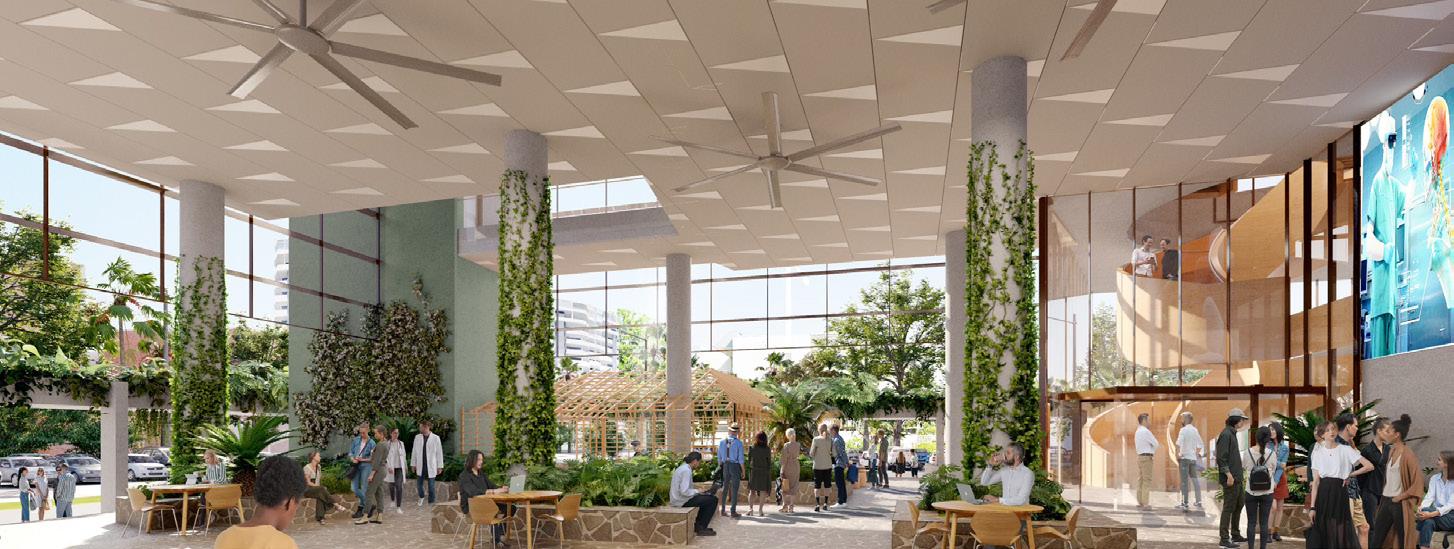
The Cairns Health and Innovation Centre (CHIC) will provide a platform for the far north to build upon its existing tropical health expertise, collaborating with universities, researchers and the private sector to tackle health challenges unique to the tropical climate. Preliminary designs include education and exhibition spaces, highly specialised simulation labs and spaces to conduct clinical trials. The CHIC will seek to address health needs locally and in neighbouring countries around tropical medicine and research and First Nations health, attracting and retaining skilled clinicians and boosting FNQ’s reputation for translational research.
$60M
QUEENSLAND GOVERNMENT COMMITMENT SECURED (STAGE 1)
INITIAL INVESTMENT
• MASTER PLANNING
• DESIGN DEVELOPMENT
• LAND ACQUISITION

An additional $87.5m was announced in the 2024-25 Queensland Budget bringing the total Queensland Government contribution to $195m. The Cairns Water Security – Stage 1 Project will secure the current and future water supply needs of the Cairns community and its growing population through the delivery of a new drinking water supply as well as improvements to the existing network to ensure resilience. The project will deliver a new water intake, a new water treatment plant and water reservoirs as well as the supporting the infrastructure required to connect to the existing network. It is the largest infrastructure project ever undertaken by Cairns Regional Council.
$195M
QUEENSLAND GOVERNMENT CONTRIBUTION SECURED
1,600+ JOBS DURING CONSTRUCTION
2026 PROJECT COMPLETION

The Cairns and Hinterland Hospital and Health Service’s (CHHHS) operations extend across Far North Queensland to some of the most remote communities in the state, with a population increasingly experiencing complex, chronic conditions at a level above national average. Cairns Hospital is the only major referral hospital in FNQ, also providing care to patients from across Cape York and the Torres Strait. Expanded health services, clinical research and education are critical to meet the health needs of FNQ’s growing population. Significantly, the region also supports a growing current visitor population of close to three million a year. Our region’s Hospital and Health Services, supported by the Northern Queensland Primary Healthcare Network, James Cook University (JCU), CQUniversity, TAFE Queensland and other tertiary institutions, are working to ensure that Cairns grows its own medical, nursing and allied health workforce, to expand its clinical services and translate research into practice to improve health outcomes for FNQ communities. Embedding research and expanding education will enable CHHHS to provide best-practice healthcare and support Cairns Hospital’s transition to tertiary hospital status within the next six years. This will allow both the hospital and JCU to attract and retain researchers and specialists, deepening health service delivery. With more than 2,000 health related student placements in 2023 alone, JCU is a major strategic partner with a growing investment into the Cairns region, such as the recent opening of a medical school allowing students to complete their full six-year training locally, and the construction of JCU’s Cairns Tropical Enterprise Centre which will provide facilities for clinical teaching, training and research.
Capacity Expansion Program Funded
• Relocate subacute care offsite to free up capacity for acute services at Cairns Hospital (by June 2023).
• Develop the Cairns Surgical Centre to enable increased surgical capacity and to increase bed capacity at Cairns Hospital for additional acute care beds.
• Invest in construction of new Health and Innovation Centre.
• Deliver new, innovative care models –virtual health, ambulatory care, clinical trials (reducing bed pressures at Cairns Hospital).
• Facilitate the partnering of third party domestic and international investors to develop a Far North Innovation, Research and Education precinct.
• Invest in an expanded hospital footprint to meet projected services demand.
• New Acute Services Building to meet critical care needs – expanded emergency dept, theatres, ICU, wards and helipad.
• Expanded sub-acute services.
• Cairns Hospital completes its transition into a full tertiary level hospital (2030).
The Cairns and Hinterland Hospital and Health Service (CHHHS) must support a growing population which creates demand for healthcare services consistently outstripping population growth. The CHHHS annual report for 2022-2023 highlighted that Cairns Hospital supports an estimated resident population of 289,000, including the regular provision of acute medical services for residents of the Cape and Torres region, an area larger than Victoria1. Cairns Hospital continues to see increased demand on its Emergency Department with more than 90,000 presentations to the Cairns Hospital Emergency Department alone in 2022-23, a 5.1% increase on 2021-222
Combined with an estimated population growth of 2.13% (compound annual growth rate) per annum and an ageing population, it is estimated that by 2032 an additional 67,000 people will reside in the catchment area with more than one in five residents aged over 60 – a third more than the national average3
With Phase 1 of Cairns Hospital’s redevelopment underway, the delivery of a new acute clinical services building in Phase 2 now becomes paramount. The requirement for a new Acute Services Building (ASB) is driven by three core elements:
Cairns Hospital is now at capacity across all bed types with no hospital bypass option. By 2036-37, this gap is predicted to be more than 360 beds. The final 16 beds available at the Cairns Private Hospital are now in use by CHHHS, capacity is now a critical risk and immediate planning is needed for a new ASB to ensure sustainable health service delivery for the medium term.
Cairns Hospital is the smallest block of developable land for comparable hospitals, and the waterfront location creates a significant service continuity risk (through flooding and storm surge exacerbated by climate change). This vulnerability was highlighted during the recent flooding event caused by ex-Tropical Cyclone Jasper, requiring CHHHS to prepare for possible patient relocation. A new Acute Services Building would significantly enhance resilience allowing for the relocation of vital infrastructure including the Emergency Department, Medical Imaging Department and pharmacy, all of which are currently located on the ground floor of the hospital. A new ASB would also see the relocation and construction of a new helipad on the ASB roof, from its current location on the heavily pedestrianised Esplanade foreshore. Not only would a rooftop helipad provide patients with the safest and most direct route to the Emergency Department and operating theatres via lift, but it would provide a long-term solution to the current Esplanade Helipad, which was erected in 1999 as a temporary solution for Cairns Hospital’s requirements.
A commitment towards the ASB would expand the hospital footprint, and enhance research and education, ultimately facilitating the delivery of more complex medical and surgical services required to improve health service delivery and ultimately achieve tertiary level status. The ASB is crucial to ensuring a successful transition, providing expanded bed capacity and selected specialty services over coming years, such as high specialty needs for older persons, paediatrics, adolescent mental health and other medical and surgical specialties. This will also include new expanded clinical and professorial roles.
A commitment to delivering Phase 2 is now vital to ensure Cairns Hospital completes its transition into a full tertiary level hospital by 2030.
OPPORTUNITY
• Increased service capacity, ensuring equitable access to health services across FNQ.
• Multinational research and education partnerships.
• Capacity to capitalise on global tropical medicine and rural generalist specialisation.
• Attract and retain skilled clinicians, researchers and innovators.
• Improve First Nations People health and wellbeing.
• Increased climate resilience.
• Improved health and wellbeing outcomes for Queenslanders.
• Growing the region’s knowledge economy and ensuring the economic resilience of the Far North.
Phase 1 of the Cairns Hospital Redevelopment is currently underway. Commitment of $6m to fund a business case into the new ASB now required.
Commit to the delivery of a new Cairns Hospital acute services building; and
Commitment of $6m to fund a business case into the new Acute Services Building, enabling Cairns Hospital to meet predicted health service demands.
1. The State of Queensland (Cairns and Hinterland Hospital and Health Service) Annual Report 2022-2023
2. Australian Institute of Health and Welfare 2024, Cairns Hospital: Total emergency department presentations, Australian Government, accessed 30 July 2024
3. The State of Queensland (Cairns and Hinterland Hospital and Health Service) Annual Report 2020-2021

An integrated and efficient road transport network is critical for economic stability and growth in Far North Queensland, a region of 380,000km2 which includes some of the nation’s most remote communities. The region’s inland roads and Cairns’ access to the northern beaches and Tablelands play a vital role in enabling the productivity of northern Australia and the contribution to the national economy through improved connectivity to southern markets. The disruption and dislocation to these road networks in the wake of ex-Tropical Cyclone Jasper have underpinned the importance of these links to the region and indeed, to the nation. Growth in population, employment, tourism and freight volumes coupled with the increasing importance of food security, means safety and capacity requirements will only grow. Investment in FNQ’s road connectivity is crucial to avoid nationally significant productivity losses, to connect rural and remote communities and to ensure continued regional and state economic development.
The road networks linking Cairns with the vital agricultural, mining and tourism regions of the Atherton Tablelands and beyond are critical enablers of the regional economy. With sizeable growth in both agriculture and mining in the region predicted in the next decade, a safe and reliable road network that enables increased heavy vehicle traffic is vital for economic growth and prosperity in the region. The road network in and out of Cairns acts as the main distribution hub for the region and is essential for further developing the agricultural and mining exports of the region. However, the growing demands for freight and increasing frequency of severe weather events, has strained the existing infrastructure, impacting transport costs and service levels across the supply chain.
The Kuranda Range Road (Kennedy Highway, Cairns-Mareeba section) links Smithfield with Kuranda and is the main coastal gateway to the Tablelands, Cape York Peninsula, and the Gulf Savannah. It is a critical link for commuter, commercial, and visitor traffic in FNQ and a vital strategic corridor underpinning the commercial viability of primary industry producers and exporters in the region in providing access to markets through the Cairns air and seaports, and road links to southern markets1. In recent years, there has been a rapid increase in traffic demand due to growth in tourism, freight movement, and residential development on the Tablelands.
Identifying an alternative to the current Kuranda Range Road would not only address FNQROC’s reports that the road is operating beyond capacity with safety and traffic efficiency now at critical levels but would ensure the region capitalises on the full economic potential of the Cairns Regional Trade Distribution Centre.
A joint commitment of $262.5m towards safety and resilience upgrades on the Kuranda Range Road has been made by the Australian and Queensland Governments (80:20). However, a permanent solution to this long-standing issue must be found. In the lead up to the Queensland State election, a commitment to conduct a preliminary evaluation and detailed business case into preferred alternative routes to the Kuranda Range Road is sought with $22m of the joint $262.5m investment allocated to fund this.
There have been 21 years of studies on the Kuranda Range Road with most recommendations not implemented. As a result, safety, capacity, and efficiency issues are now at a critical point with the recent extreme rainfall in the wake of ex-Tropical Cyclone Jasper highlighting this once again. Failure to address this issue has also resulted in constraints on economic development in the region, as evidenced by the abandoned $640m KUR-World tourism development project. Continued growth in tourism, agriculture, mining, and population on the Tablelands and beyond mean it is imperative that a solution is developed for Cairns to Tablelands access prior to a major crisis.
• Increased economic and social outcomes, opening up potential new dormitory suburbs for a growing and linear city.
• Unlock critical supply chains, improving the region’s freight network.
• Improve safety and security.
• Improve national and regional connectivity.
Intelligent Transport Systems treatments on the Kuranda Range Road have been installed with the project completed in March 2024.
Commitment sought towards a preliminary evaluation and detailed business case into preferred alternatives of the Kuranda Range Road.
The current review of the Far North Queensland Regional Plan is nearing completion and early engagement has identified population growth and the linear geographic constraints of Cairns as a major issue. The plan is due to be completed by late 2024.
Commitment to conduct a preliminary evaluation and detailed business case into an alternative route to the Kuranda Range Road, with $22m of the joint federal and state government investment of $262.5m allocated to fund this.
1 FNQROC, Kuranda Range Road, August 2019, https://www.fnqroc.qld.gov.au/files/ media/original/004/98d/138/272/FNQROC-Kuranda-Range-Road-August-2019-_ DIGITAL.PDF

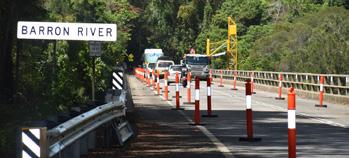

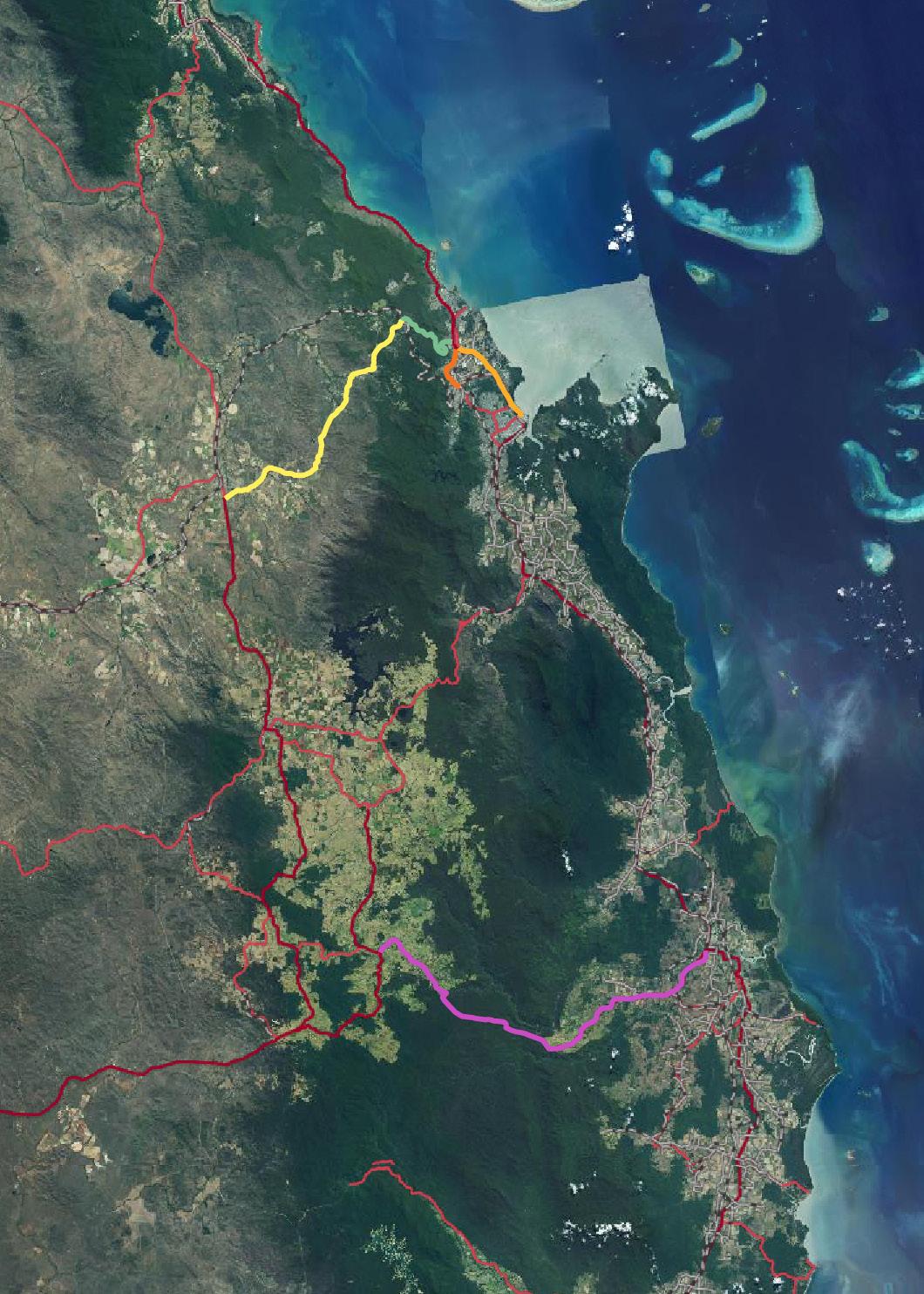
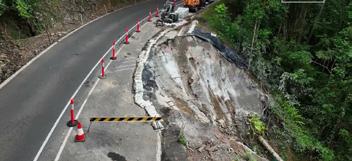

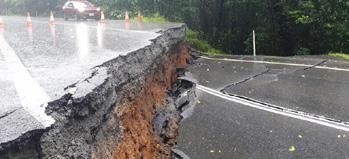
There are other impediments to a safe and efficient transport corridor with the Barron River bridge (Kennedy Highway at Kuranda) facing ongoing single lane traffic restrictions due to concerns over its safety and stability. As of September 2024, the bridge reopened to two lanes, however further restricted the load limit from 50.5 tonne to 42.5 tonne. A business case is currently underway to identify a preferred long-term solution – either rehabilitating or replacing the bridge. The Queensland Labor Government have made an election commitment of $450m to deliver a new bridge over the Barron River at Kuranda Range with construction to be complete by 2031.
The government must prioritise delivery of the new Barron River Bridge, ensuring construction is complete sooner, by 2029 rather than out to 2031. Not only will this ensure the safety of the community but will also address the critical need for improved network efficiency and connectivity, that currently impedes economic development. This accelerated delivery would also mitigate risks associated with the aging infrastructure in place, currently subject to intermittent single lane operations since 2020, in addition to heavy vehicle weight reductions.
OPPORTUNITYOPPORTUNITY
• Improve safety and security.
• Improve and ensure a resilient regional freight network.
• Improve environmental sustainability of the bridge.
• Enhance productivity.
In July 2024, the Queensland Labor Government made a commitment of $450m to deliver a new Barron River Bridge by 2031.
A commitment to complete construction by 2029 is now sought.
1. Ensures the Barron River Bridge detailed cost estimate and business case is completed by the end of 2024 – in accordance with current timelines identified; and
2. Accelerated delivery of the new Barron River Bridge, ensuring construction is complete by 2029 rather than out to 2031.
1 Department of Transport and Main Roads, Kennedy Highway (Cairns – Mareeba), Barron River bridge upgrade, planning, last updated October 30, 2023, https:// www.tmr.qld.gov.au/projects/kennedy-highway-cairns-mareeba-barron-river-bridgeupgrade-planning
The National Land Transport Network (NLTN) outlines nationally significant road and rail infrastructure links and their intermodal connections. The legislation aims to assist economic and social development through the provision of Commonwealth funding aimed at the improvement of land transport infrastructure.
In recognition of its importance, the Captain Cook Highway, Cairns CBD to Smithfield was added to the NLTN under the 2020 determination1. The objectives of an integrated land transport network include improving national and regional connectivity for communities and industry; improving national, regional, and international logistics; and trade and consistency with viable, longterm economic and social outcomes2.
Continuing the NLTN from Smithfield to Mareeba, and ultimately to Weipa, would meet these objectives and ensure the continued economic and social development of the Atherton Tablelands region and beyond. It would be the next logical step in the network, with Mareeba being the gateway to the region’s agriculture production areas of Atherton Tablelands, Cape York Peninsula, and the Gulf of Carpentaria.
• Improved connectivity between Cairns and the region’s agricultural production hubs on the Atherton Tablelands.
• Increased social and economic outputs.
• Provides pathway towards increased connectivity between key national security assets (Port of Weipa and RAAF Base Scherger).
Commitment to work with the Australian Government to amend the National Land Transport Act 2014 to extend the national highway designation from its current terminus at the intersection of Captain Cook and Kennedy Highways to the intersection of the Kennedy Highway and the Mulligan Highway, and ultimately, to extend that vital network across to the Western Cape, to Weipa.
1 National Land Transport Network Determination 2020 (Cth)
2 National Land Transport Act 2014 (Cth)
The Palmerston Highway is a key strategic link connecting the southern Tablelands to the Bruce Highway, Port of Mourilyan and Innisfail. As the only road facilitating B-double access to the Tablelands, the Palmerston Highway functions as the region’s primary freight route, playing a critical role in connecting Far North Queensland’s agriculture and mining sectors with southern markets in addition to providing access to tourist attractions and is central to waste management. However, it requires significant investment to maintain crucial access and enhance the resilience of the route.
Catastrophic flooding associated with ex-Tropical Cyclone Jasper has highlighted not only the importance, but the vulnerability of the Palmerston Highway. The highway remained closed for nearly two months, with a temporary single lane section opening in early February 2024, after the road suffered significant structural damage.
Located in the Wet Tropics World Heritage Area, the region’s topography is challenging and particularly susceptible to flooding, landslides and fallen vegetation. In the four years to 2019, 76% of closures to the Palmerston Highway were due to environmental factors. Closures to the highway result in B-double traffic having to either wait, breakdown their vehicle to access an alternative range route (provided these are open) or divert and use the inland route via Townsville, resulting in at least a two hour increase to travel time1.
Whilst remedial work on the Palmerston Highway continues, investments in infrastructure resilience, including planning, design, construction and maintenance are essential to ensure the long-term sustainability of the Palmerston Highway, secure supply chains and increase connectivity and efficiency.
• Securing the nation’s access to a major Australian food bowl.
• Increased resilience in the wake of increasingly frequent and severe weather events.
• Unlock and secure critical supply chains, improving the region’s freight network and waste management industry.
• Increased economic and social outcomes.
• Improve safety and security.
• Improve national and regional connectivity.
Following significant structural damage, the Palmerston Highway reopened with a single temporary lane in early February. However, it is essential the road is upgraded to ensure its long-term viability.
Significant investment from the state and federal governments required.
In partnership with the Australian Government, significant investment to upgrade and safeguard the Palmerston Highway accounting for its unique and complex topography and ensuring its future sustainability and functionality long-term.
1 The State of Queensland (Department of Transport and Main Roads), Cairns to Northern Tablelands Access Strategy, July 2021

The Savannah Way traverses northern Australia, linking Cairns in FNQ to Broome in Western Australia’s Kimberley. The route is about 3700km long, crossing 15 national parks and five World Heritage areas as it navigates the Top End.
Considered to be in the top 10 road trips of Australia, the self-drive tourism market delivers $69.8m annually into the Gulf region1, with 38% of visitors starting the journey in Cairns.
The Gulf section of the Savannah Way takes in 888km from Forty Mile Scrub west of Mt Garnet to the Northern Territory border, with significant sections of the road already sealed. However, there are many substantial sections that require pavement upgrades, bitumen seal, minor realignment of substandard curves, concrete causeways, and four major river crossing upgrades.
Recognising the need to seal the Gulf section of the Savannah Way, in 2019 the Australian and Queensland Governments committed $62.5m for road upgrades through the Roads of Strategic Importance – next priorities initiative. This will be spent across various shire councils, with a prioritised list formulated in 2021. The Mt Garnet to Carpentaria Shire border section is 510km and requires funding to upgrade the road and floodways for reliability and to meet current construction and safety standards for heavy vehicles, tourists and commuters. This includes approximately $25m to upgrade the low-level river crossing at Gilbert River between Georgetown and Croydon. The river crossing is vital to the Gulf Savannah region and highly susceptible to flooding with unsafe entry and exit points2
Burke Shire to the Queensland border requires further sealing, widening and improvements, including upgrading the causeway crossings at Gregory River (near Tirranna Springs Roadhouse) and Nicholson River (near Doomadgee).
Upgrading the remaining sections is estimated to require:
• $40m to finish sealing 72km between Normanton and Burketown3
• $41m to seal 55km between Hells Gate and the Queensland border3
• $25m (approx.) to upgrade the Gilbert River crossing.
• Increased economic and social outcomes.
• Improved safety and resilience.
• Improved regional connectivity particularly in isolated and remote communities.
• Supports local workforce development and retention.
Major investment has been made to seal around 3,200km of the route.
Further funding required to complete a final 172km in Queensland.
In partnership with the Australian Government, commit to supporting the sealing and improved flood resilience of the Gulf section of the Savannah Way by investing:
• $40m to seal 72km between Normanton and Burketown
• $41m to seal 55km between Hells Gate and the Queensland border
• $25m to upgrade the Gilbert River crossing
1. Gulf Savannah Development, Tourism Survey Report, March 2018, https://www. burke.qld.gov.au/downloads/file/522/gsd-tourism-report-2018
2. Gulf Savannah Development, 2024-25 Queensland Budget submission
3. NWQROC, Developing Northern Australia Conference Paper, July 2023
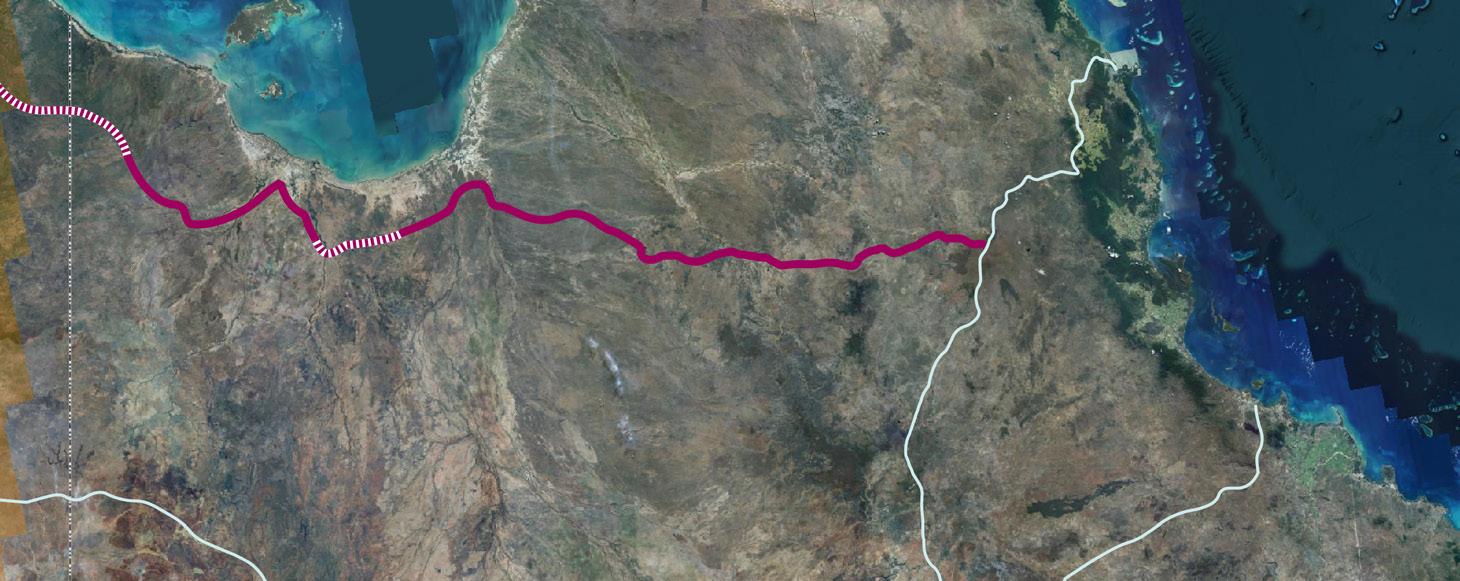
Savannah Way (Gulf Section)
UNSEALED - Savannah Way (Gulf Section)
National and State Roads
The road network spanning Cairns’ northern beaches is of regional significance and remains essential to Far North Queensland’s future prosperity and liveability. A cohesive and effective road network between Cairns’ CBD and northern beaches guarantees access to vital healthcare, education and community services in addition to resident, tourist and trade and business connectivity.
An integrated and efficient road transport network is critical for economic stability and growth. Population growth in FNQ, and the Cairns northern beaches in particular, calls for an immediate response with this corridor plagued by accidents, lengthy delays and bottlenecks.
The road network provides vital access to the region’s resident population of more than 285,0001 (with up to 50,000 tourists per day during peak holiday season) ensuring accessibility to health, education, community services and business. Due to continued population growth, FNQ’s road transport system faces increasing pressure – which is particularly evident on Cairns’ northern beaches. Meeting the growing demand for freight has strained existing infrastructure, impacting on transport costs and service levels across the supply chain.
The need to upgrade Captain Cook Highway to enhance connectivity was recognised by the Australian Government in the National Land Transport Network Determination 2020. The National Highway A1 was extended by the Australian Government in 2020 to the intersection of Captain Cook and Kennedy Highways and Mount Milman Drive, Smithfield, north of Cairns. In 2019, prior to this road re-classification, the Australian Government announced it would fund the road upgrades to Smithfield together with the Queensland Government on an 80:20 basis.
Master planning for the Captain Cook Highway, Cairns CBD to Smithfield, upgrade is currently underway with a priority $359m Stage 1 project identified (Florence Street to Aeroglen Drive). Master planning, including a staged approach for upgrades, is expected to be complete mid-2025.
With Cairns’ (SA4) population projected to reach over 330,000 people by 20462 (a forecast which we believe is underdone) – an increase of more than 75,000 – the geographic constraints of a linear city bound by the World Heritage-listed mountains and rainforest to the west and the Great Barrier Reef Marine Park to the east significantly impedes both population expansion and the ability to build new roads. Upgrades to the Captain Cook Highway, Cairns CBD to Smithfield are of even greater importance in the wake of record-breaking flooding in the wake of ex-Tropical Cyclone Jasper, highlighting the region’s vulnerabilities relating to transport and infrastructure. It is imperative for the future prosperity and liveability of Cairns that the Captain Cook Highway, Cairns CBD to Smithfield, upgrade be undertaken as a matter of urgency to meet pressing current and future needs. This is critical to building a resilient future for the region.
• Enhance regional connectivity.
• Enhance disaster and climate resilience.
• Improve accessibility.
• Decrease travel time, increase road network reliability and boost productivity.
• Improve safety, reducing number and severity of crashes.
• Encourage use of active and public transport.
Master planning, including a staged approach for the upgrades is underway. The expected completion date for this work was late 2023, however this has been deferred until mid-2025.
Once planning work is finalised, TMR will develop a detailed program of construction timeframes for the priority (Stage 1) project.
Commitment to allocate at least $96m towards the Captain Cook Highway (Cairns CBD to Smithfield upgrade) over four years from 2024-25 in accordance with the Queensland TransportandRoadsInvestmentProgram2024-25to2027-28.
1. Economy.id, Population, Far North Queensland Regional Organisation of Councils, last updated June 30, 2023, https://economy.id.com.au/fnqroc/population
2. Queensland Government population projections, 2023 edition; Australian Bureau of Statistics, Regional Population, 2021
The Cairns Western Arterial Road (CWAR) is central to freight, commuter and tourism traffic and supports resilience and connectivity when the Captain Cook Highway, Cairns CBD to Smithfield is flooded.
The effectiveness and safety of the road transport network in and around Cairns will continue to be adversely impacted until the CWAR is fully duplicated from Redlynch to Smithfield and in line with an upgrade of major intersections. A total commitment of $300m has been pledged by the Australian and Queensland Governments on an 80:20 basis to duplicate from Redlynch Connector Road to Captain Cook Highway.
The CWAR is considered a priority infrastructure project as the road is heavily congested daily, with about 42,000 vehicles using the road each day1. Further, when the Captain Cook Highway floods in the event of a natural disaster or during wet season, CWAR is the only flood-free access route between Cairns, the northern beaches, and the Kennedy Highway. Increasing extreme weather events make this all the more imperative, as evidenced during the recent widespread flooding in the wake of ex-Tropical Cyclone Jasper where CWAR was one of the few major roads to remain open throughout the flooding, albeit the road was overwhelmed.
Upgrading CWAR is essential to connecting Cairns’ freight routes with the region’s premier areas of agricultural production

(Tablelands, Cape York Peninsula, and Mossman), while also meeting demand for daily commuter traffic. At the 2020 Queensland state election, the Queensland Government pledged $60m to upgrade the CWAR. In the 2021-22 Federal Budget, the Australian Government committed a further $240m to upgrade the remaining single lane sections of the CWAR. Despite the initial commitment made almost four years ago and a total of $300m in funding committed to complete the CWAR with work originally slated to begin in late 20222, construction is yet to commence.
It is now imperative that the Queensland and Australian Governments work together to expedite construction, preventing further delays to this network.
• Contribute to the growth of the regional economy, improving connectivity.
• Enhance disaster and climate resilience.
• Decrease travel time while increasing network reliability and efficiency.
• Improve safety.
• Encourage use of public and active transport.
In the 2023-24 Federal Budget, the Australian Government announced a strategic review of its investments across Australia through its Infrastructure Investment Program (IIP).
The Department of Transport and Main Roads is currently working towards meeting the Australian Government’s requirements to facilitate the release of the construction funding.
In the meantime, the Queensland Government has released funding for preparation works for Section 1 (Lake Placid Road to Captain Cook Highway).
Preparation works for Section 1 are expected to commence in late 2024, weather and other circumstances permitting.
Commit to working with the Australian Government to meet requirements necessary for the release of the Australian Government’s contribution towards construction funding and subsequently coordinate the expedited delivery of the Cairns Western Arterial Road (Redlynch Connector to Captain Cook Highway duplication), preventing further delays to this critical network.
Kuranda Range Road
Cairns Western Arterial Road (CWAR)
Captian Cook Highway (C2S)
Commitment to allocate at least $197m towards the Cairns Western Arterial Road (Redlynch Connector to Captain Cook Highway duplication) over four years from 2024-25 in accordance with the Queensland Transport and Roads Investment Program 2024-25 to 2027-28.
1. Infrastructure Australia, Cairns Western Arterial Road capacity, last updated April 4, 2023, https://www.infrastructureaustralia.gov.au/map/cairns-western-arterial-roadcapacity
2. Mark Bailey, “Work wraps up on Harley Street intersection upgrade”
CAIRNS AIRPORT AVIATION MAP
Eastern Aviation Precinct
Private Aviation & Tourism Operators
Maintenance, Repair and Overhaul (MRO)
Emergency Services Base
Future-ready Terminal Precinct
Freight Precinct
General Aviation Precinct
Airport Industry Precinct

Cairns’ General Aviation Precinct is a major contributor to the regional economy, and is home to more than 100 businesses including major maintenance, repair and overhaul (MRO) businesses, education and aeronautical skills training providers, freight consolidation services, tourism operators, and rescue and charter flights.
Cairns Aviation Skills Centre and CQUniversity produce highly skilled aircraft engineers and pilots who are then employed in well paid jobs in the local economy. These organisations are already delivering on some of the aspirations outlined in the recently released Aviation White Paper – Towards 2050. Together, they have the potential to deliver so much more with targeted support. The key themes are:
• Address industry demand
• Enhance safety
• Support workforce development
• Promote innovation
• Connecting regional Australia
• Regenerating general aviation
Far North Queensland’s MRO sector is vital to the region’s connectivity, servicing fixed wing and rotary aircraft that ply the Cape, Torres Strait, Papua New Guinea and the wider Asia-Pacific. These services ensure emergency and humanitarian aid as well as FIFO flights and provide critical connectivity to areas where it matters most.
Through the establishment of a state-of-the-art Aviation Maintenance Training Facility, Cairns could cement itself as the premier location in North Queensland for aeronautical skills training and as a key base for aircraft maintenance, repair and overhaul (MRO).
The General Aviation sector is the backbone of the broader aviation industry, providing Australia with the skills, innovation and expertise required to grow the industry and train the next generation of aviation professionals1. There is a significant shortage of key aviation workers, including pilots, flight instructors, aircraft maintenance engineers and engineer instructors, directly preventing the aviation industry from growing to meet demand, and creating additional pressure on the existing workforce. This trend is set to continue with increased demand forecast throughout the industry, resulting in international competition for skills, and further exacerbating the already disproportionate impact workforce shortages have on both regional areas and general aviation across Australia.
With the vision for the future of Australia’s aviation workforce to be diverse, highly skilled and responsive, Cairns is already positioned to provide clear pathways for training for both pilots and aircraft maintenance engineers. Situated at the airport and aligned closely to industry, the Cairns Aviation Skills Centre and CQUniversity can support the growth of under-represented populations within Australia’s aviation sector – First Nations people, women and students from non-English speaking backgrounds – by providing relevant training and support required to meet increased demand through the establishment of an Aviation Maintenance Training Facility.
The Aviation Maintenance Training Facility would bridge the current and projected shortage of skilled aviation engineers and pilots through increased comprehensive and contemporary training that meets industry standards and prepares graduates for immediate employment, particularly with the co-location of a new fit-for-purpose common use hangar. This proposed state-of-the-art Facility would provide students with direct practical experience whilst enabling current MRO operators to expand operations. The new hangar would provide capacity for three mid-sized jet aircraft (Boeing 737 or Airbus A320) to be maintained simultaneously.
This additional capacity would also provide Far North Queensland with the opportunity to capitalise on the significant demand for regional jet maintenance with about half of the fleet currently maintained overseas. Although regional jets can access cheaper international maintenance providers, airlines with high asset utilisation prefer to have jets maintained domestically to reduce downtime. As the only regional airport in Australia with international capacity to attract new customers, Cairns possesses two highly capable MRO operators currently working at capacity, but willing and able to expand if maintenance infrastructure were available. As a direct result of the constrained infrastructure, an estimated $15m in business was lost to the region in the past 12 months alone. These MRO operators do not have the resources to individually invest in the
large structures required to make a step-change in the size and type of aircraft that they maintain.
In response to the growing demand for aircraft MRO, aviation maintenance professionals and the need to enhance safety and operational efficiency in the aviation industry, government support is sought to deliver a state-of-the-art Aviation Maintenance Training Facility. This facility will serve as a hub for technical education and hands-on training, equipping individuals with the skills and knowledge required to excel in aviation maintenance roles.
• Training aircraft and equipment: real-world aircraft and advanced maintenance equipment for hands-on training, supported by industry for industry.
• Classrooms and simulation labs: modern classrooms and simulation labs equipped with the latest technology to provide theoretical knowledge and practical experience.
• Workshops and technical labs: dedicated spaces for practical exercises and technical skills development including a worldleading Composite Centre of Excellence which not only supports aviation but also maritime industries.
• Instructor offices and administrative areas: facilities for faculty and administrative functions, ensuring smooth operations and support for students.
• Safety and compliance areas: designed to meet industry safety standards and regulatory requirements.
$88M ECONOMIC VALUE ADDED 2
Latest data shows Cairns’ aircraft MRO sector contributed $36m in value-added output to the regional economy.
913
MRO and training facilities accounting for ~ 700 employees - 372 of whom are dedicated to MRO services alone.
The MRO and training facilities offer a steady stream of apprentices, providing critical training and career pathways in both trades and highly skilled professional roles.
Work on Cairns Airport’s new Eastern Aviation Precinct is underway with the Airport investing an initial $40m to deliver new aircraft stands and enabling infrastructure. The new Eastern Aviation Precinct is the ideal location for the Aviation Maintenance Training Facility that can meet required demand, keep business in the region and attract new highly skilled jobs to Far North Queensland. Importantly, this facility would also underpin the stated strategic importance of northern Australia to the nation’s interests as laid out in the Australian Government’s Defence Strategic Review. This would see that the region’s aviation infrastructure is sufficiently robust and scalable. Regional investment to deliver improved infrastructure at Cairns Airport would result in increased support for Defence into the future and can support rapid deployment and resupply in times of need – a regional focus area highlighted within the FNQ Regional Infrastructure Plan 3
A state government investment of $50m is sought to support the infrastructure development of this critical project.
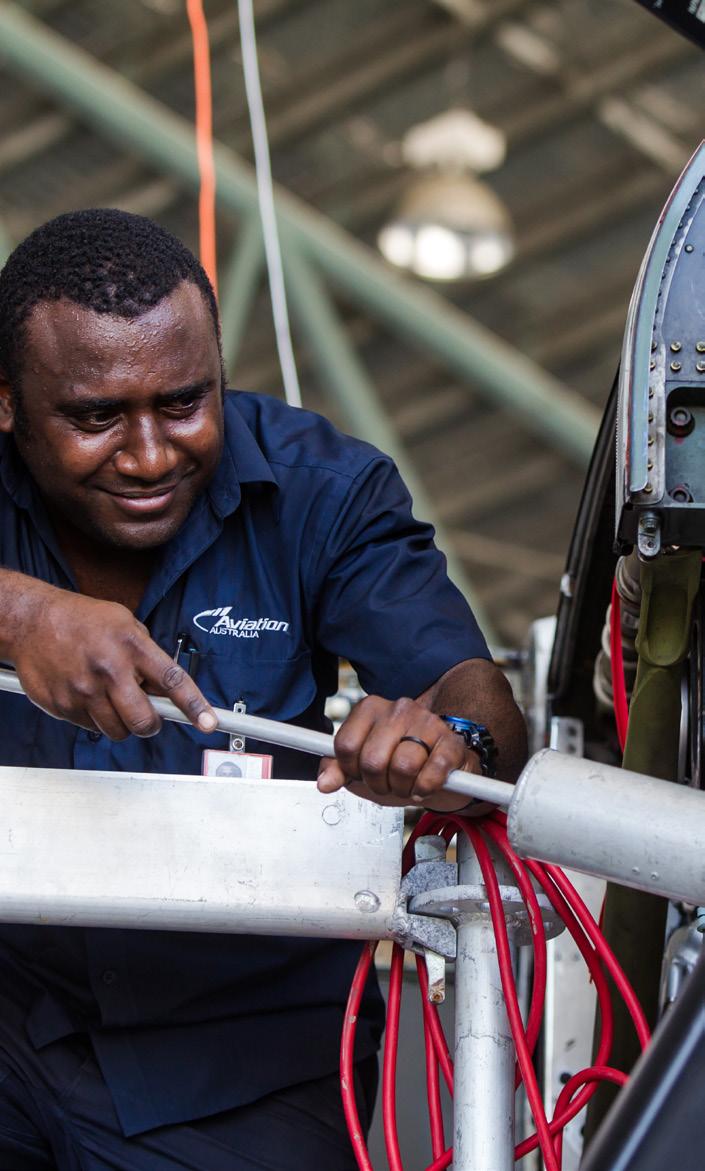
OPPORTUNITY
OPPORTUNITY
• Workforce development: address industry shortages through skilled and non-skilled job creation, attraction and retention; increase employee diversity, new career pathways, apprenticeships and program offerings in regional Australia.
• Expand regional training facilities: establish a leading training facility known for excellence and innovation, ensuring FNQ is at the forefront of aviation and maritime technology, strategic readiness and capacity building.
• Enhanced safety and resilience: improved maintenance practices, contributing to higher safety standards; supports disaster resilience.
• Economic growth and impact: support 100 jobs during construction; increased operational efficiency; deliver longterm benefits to the local community by offering study, training and work opportunities in Cairns; attract investment across the general aviation sector maximising commercial uptake alongside Cairns Airport’s initial $40m investment in the new Eastern Aviation Precinct.
PROJECT STATUS
PROJECT STATUS
State investment of $50m is required to develop a state-of-the-art Aviation Maintenance Training Facility to ensure the required training can be undertaken to support a skilled workforce into the future for the aviation industry and drive growth in Australian aviation at a time of critical workforce shortage and the increasing strategic importance of the North.
$50m to deliver a state-of-the-art Aviation Maintenance Training Facility within the Cairns Airport Eastern Aviation Precinct. The Facility would encompass a 10,000m2 hangar which is to be operated under a common user model incorporating Cairns Aviation Skills Centre as the proponent, with ownership of the Facility to revert to the state.
1 Department of Infrastructure, Transport, Regional Development, Communications and the Arts, Aviation White Paper – Towards 2050 (Canberra: Commonwealth of Australia, 2024).
2 Cairns Airport, Economic Assessment & Airport Census, September 2022.
3 State of Queensland, Department of State Development and Infrastructure, Far North Queensland Infrastructure Plan. 2024.
The Cessna Caravan (C208) light aircraft is ideally equipped for versatile, remote operations in demanding conditions and is widely used across the region by a number of commercial operators. It is the most commonly used aircraft by Far North Queensland-based MAF International (MAF), the world’s largest humanitarian airline and the proponent of the simulator.
The C208 aircraft provides critical access to remote communities which would otherwise be isolated. There are currently 152 registered in Australia, with more on the way, and close to 300 in the immediate region.
Pilot training currently takes place within aircraft in flight, allowing little room for pilot error in treacherous and remote terrain and unpredictable climactic conditions. The simulator provides a step change in sustainability for rural aviation, offering a unique carbonisation reduction opportunity. With more than 2600 of these aircraft currently in operation worldwide and an 18 month wait time on new units, the popular C208 airframe is resilient and will remain relevant for decades into the future, having been handpicked for development of full electric engine capability. Additionally, the widespread use of the C208 in challenging conditions has seen a number of incidents which have resulted in both human and capital loss. With some models carrying up to 12 passengers, the impact of one accident prevented far exceeds the implementation costs of the simulator.
By removing the need to conduct elevated risk training manoeuvres in the air, the simulator not only provides significant value in reducing in-aircraft training times, saving operators hours in maintenance, but also keeps aircraft online for operational use. Further, in the present context of pilot shortage, the simulator provides an opportunity to fast-track pilots towards industry readiness, enabling repeated exposure to difficult operational scenarios that quickly develop pilot competency.
MAF estimates that greater than 60% of selected training can be migrated into the simulator, covering initial ratings and recurrent training. A reliable feature of rural aviation for decades to come, the C208 is an aircraft type commonly flown by less experienced pilots on a pathway towards airline careers. The simulator provides an environmentally sustainable base for improving safety in general aviation and providing valuable career skills that enable future growth in the Australian airline industry.
A Cessna Caravan simulator would be the first of its kind outside the United States and would provide a steady stream of new pilots prepared in a safe environment for unique regional conditions. It would also ensure that current pilots are upskilled on an ongoing basis. Together with the Cairns Aviation Skills Centre (CASC) and Aviation Australia, Australia’s only Cessna Caravan simulator would cement Cairns as a national flight training hub, complementing the pilot training offered through CQUniversity’s aviation school.
The simulator would align with the training offered at the Queensland Government’s Cairns Aviation Australia facility within the industry led CASC, and also attract pilot trainees from across the region, helping build capacity in the Pacific, particularly in Papua New Guinea (PNG) where MAF is currently expanding its training offerings for new pilots, under its Mareeba flight school – the only
offshore flight school accredited by CASA PNG. In addition, MAF has a long-standing pilot training program through its operations in East Arnhem Land and hopes to further expand its Indigenous training program.
Establishing Australia’s first Cessna Caravan full flight simulator in Cairns and cementing the region’s position as a premier aviation training hub, requires a capital investment of $8m from the Queensland Government. This investment would unlock the opportunity to accelerate the implementation of this asset by years, bringing critical safety outcomes and alleviating pilot shortages without delay. MAF International has committed to ensuring the success of the project by covering costs associated with all operating expenses, estimated to be in excess of AUD$1m p.a., including support, maintenance, administration and logistics staff and device and facility maintenance. The Australian Government Office of Impact Analysis rates the Value of Statistical Life (VSL)1 at $5.4m per individual, meaning that the value proposition of this investment is beyond question, making the success of this project a key commitment of MAF International.
OPPORTUNITY
OPPORTUNITY
• Australia-first Cessna Caravan full flight simulator, cementing the Far North as a premier aviation training hub.
• Significant potential to establish Cairns as the national hub for pilot training for the Cessna Caravan, in partnership with the Queensland Government’s Aviation Australia at the CASC.
• Introduce new standards of safety and enhanced pilot training for pilots who typically service rural and remote parts of Australia, PNG and the Pacific.
• Free up aircraft for commercial, humanitarian and emergency use in the region.
• Train and build capacity throughout Indigenous communities, as well as PNG and the Pacific (adopting a model similar to the current Pacific Maritime Security Program conducted in Cairns at the TAFE Great Barrier Reef International Marine College).
The lack of access to simulator training for Cessna Caravan pilots is limiting critical commercial and humanitarian services, and creating material safety risks. Investment of $8m required.
$8m to establish Australia’s first Cessna Caravan full flight simulator (to be operated on a common user model) to ensure safe training across commercial and humanitarian sectors, establishing the city as the only such centre for specific pilot training across Australia and the wider Asia-Pacific.
1 Australian Government, Department of the Prime Minister and Cabinet, Office of Impact Analysis. 2023. Valueofstatisticallife. https://oia.pmc.gov.au/sites/default/ files/2023-10/value-of-statistical-life.pdf
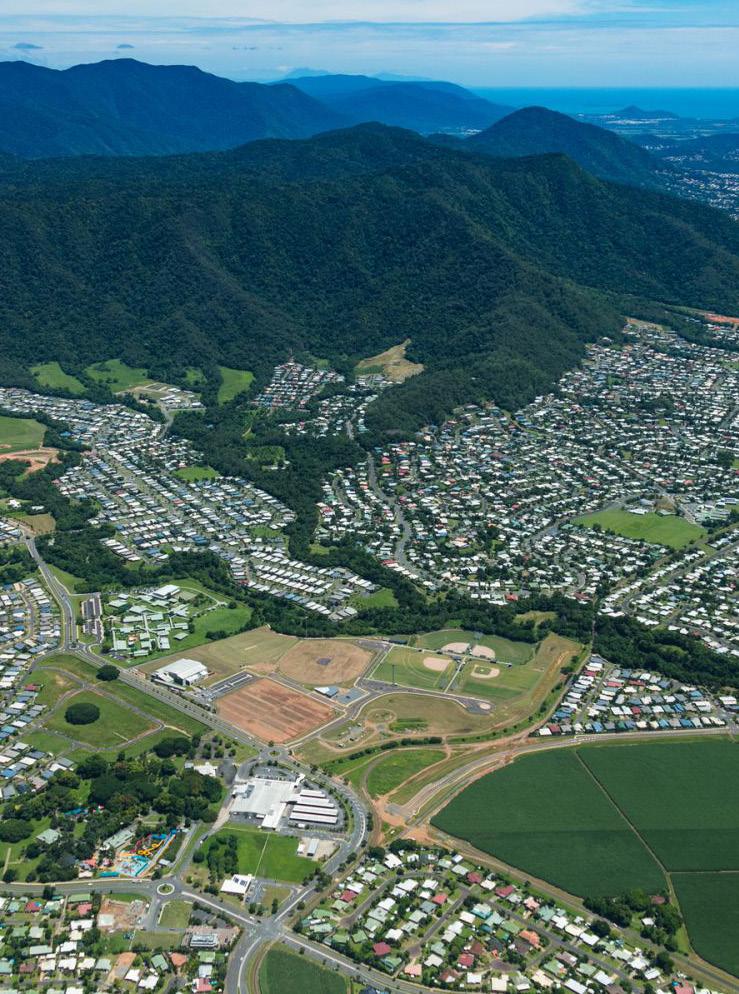
Like many communities across Australia, Cairns desperately requires solutions to address the housing crisis currently being experienced, a problem made even worse in the wake of household displacement caused by ex-Tropical Cyclone Jasper. With a rental vacancy rate of 0.7%1, Cairns has one of the lowest rental availabilities in the nation. This crisis is amplified across the economy with housing a critical enabler of growth. This shortage of dwellings places additional pressures on the region’s ability to attract and retain staff across the board. Driven by a combination of factors, including population growth, limited housing supply, rising construction costs and labour shortages, Australia’s housing crisis is a multifaceted issue requiring interventions from all levels of government, the private sector and not-for-profit sector.
Cairns Regional Council is actively working to ensure there is an appropriate supply of approved land available for development within existing serviced areas right now in addition to the provision of incentives for community housing providers who build social or affordable housing and for private sector proponents delivering infill housing development within the Cairns City, Cairns North, Gordonvale and Babinda centres.
While addressing immediate housing needs is critically important, medium to long term planning is essential to ensure similar situations can be avoided in the future. This means taking a collaborative approach to planning and infrastructure delivery for key areas where housing and economic development will take place.
The Mount Peter Southern Growth Corridor covers a total land area of about 3,300 hectares to the south of Cairns in an area between Edmonton and Gordonvale on the western side of the Bruce Highway. Around half of that total land area is considered to be developable having regard to environmental and other hazardbased constraints. The area has the capacity to deliver around 18,500 new dwellings for an estimated 42,500 people.
The Mount Peter Southern Growth Corridor is the only remaining greenfield development area of this scale within the Cairns Local Government Area and is forecast to accommodate the vast majority of Cairns’ long term population growth. The Queensland Government Statistician’s Office projects total population growth (modestly in Advance Cairns’ opinion) for the Edmonton and Gordonvale – Trinity SA2 areas (the SA2 areas within which the Mount Peter Southern Growth Corridor is located) of around 25,000 people from 2021 to 2046 – accounting for 37% of Cairns’ total projected population growth during this timeframe. Planning for the future development of the Mount Peter Southern Growth Corridor will be critical to support positive housing and community outcomes and ensure the right infrastructure is delivered in the right place and at the right time to accommodate growth.
Cairns South State Development Area
Bruce Highway

APPROX. LAND AREA:
3,300 HECTARES
18,500 NEW DWELLINGS ESTIMATED HOUSING CAPACITY:
42,500 PEOPLE
The dwelling mix within the Mount Peter Southern Growth Corridor can support the changing demographic needs of the community and will deliver social and affordable outcomes. It is expected the Mount Peter Southern Growth Corridor will continue to supply the housing needs of the region well beyond 2046 and support self-containment in the corridor with a range of jobs in well planned retail, commercial and industrial zones. This includes the adjacent Cairns South State Development Area (SDA) declared in 2018 which offers significant opportunity for the region and has the potential to provide an important source of employment proximate to the growing Mount Peter corridor.
Advance Cairns urges the Queensland Government to take the necessary steps to realise the potential of the SDA to secure “regionally significant industry” for the site.
Cairns Regional Council has now made a formal request to the Minister for State Development and Infrastructure seeking the declaration of a PDA over the Mount Peter Southern Growth Corridor as a matter of urgency. Advance Cairns wholly supports this request, recognising the substantial economic and community benefit a PDA would deliver through fast tracked development and infrastructure delivery, providing for medium to long term housing development, including a significant affordable housing component.
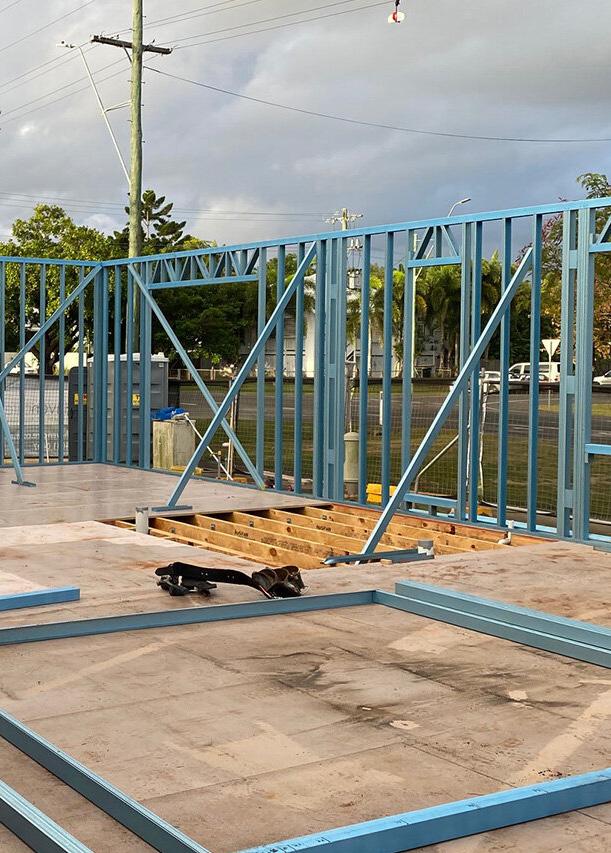
• Unlock medium to long term housing development.
• Provide fast tracked development and infrastructure delivery (road networks, public transportation, utilities etc) through a simplified planning and approval process.
• Support initiatives outlined in the Queensland Government’s Homes for Queenslanders plan.
• Deliver diverse housing options, including affordable and social housing, to meet the needs of all residents, particularly those in lower-income brackets and vulnerable cohorts.
• Formalise a collaborative approach between state and local government for planning and infrastructure delivery to ensure this takes place in a coordinated way.
• Complement the existing Cairns South State Development Area (located adjacently) which is earmarked for regionally significant industrial development/employment.
• Maximise potential for ‘living and working locally’ shortening commute times and enhancing liveability.
Cairns Regional Council has formally sought the declaration of a PDA over the Mount Peter Southern Growth Corridor as a matter of urgency.
Declare a Priority Development Area over the Mount Peter Southern Growth Corridor, under the Economic Development Act 2012, and work collaboratively with Cairns Regional Council, industry and other stakeholders on planning and infrastructure delivery within this PDA to support medium to long-term housing supply.
James Cook University is committed to meeting the needs of domestic and international students in Cairns. These students contribute to the regional economy and their work as professional graduates is an important factor in growing Cairns. Students require safe, affordable and appropriate housing.
The existing self-catered John Grey Halls student accommodation located on the Nguma-bada, Smithfield Campus is at capacity. John Grey Halls student accommodation is a 300-bed facility occupied by 60% domestic and 40% international students. In addition, other student accommodation providers are moving out of this student sector, leaving a critical shortage and further exacerbating the housing crisis in Cairns. These halls provide fit for purpose accommodation for students who would otherwise be forced to enter into the general housing market, directly impacting the limited supply available for residents.
To address the immediate housing needs of Cairns, James Cook University (JCU) has developed an initiative to deliver a 250-bed student accommodation facility, alleviating pressure on Cairns’ rental market by releasing rentals currently occupied by students back into the general community, whilst also contributing to a more vibrant and dynamic precinct for Cairns.
This development requires capital funding of $60m. It is proposed that this be funded jointly by federal and state governments, with contributions of $25m each, and a contribution of $10m from JCU. In addition, JCU will provide the land, intellectual capital, the governance structure, and project management team required to successfully deliver this project.
JCU has a proven track record in the delivery of significant capital developments including the recently (2022) completed $55m, 400 bed Burralga Yumba Student accommodation complex on the Bebegu Yumba campus in Townsville.
Augmenting existing designs for the recently completed student accommodation without the requirement for DA will allow JCU to fast track this project.
• Scarce freehold land available in Cairns and Smithfield and the CBD.
• Address immediate housing needs of Cairns.
• Increase Cairns’ growth, economy and overall liveability.
• Promote continued growth in the education sector and increase economic diversification as well as the compounding economic return from students studying and working in the city.
• Positive reflection on Cairns as a student-friendly city and demonstrate commitment to education.
• Supports JCU’s recruitment and retention of a diverse student body through an improved living and study experience.
• Promote diversity through a broad range of accommodation offerings, catering to different needs and preferences.
Capital funding of $60m required to deliver the accommodation project.
Joint federal and state commitment of $50m (50:50) sought. JCU will contribute the remaining $10m. With this funding support, JCU can fast track this accommodation project.
In partnership with the Australian Government, a joint commitment of $50m ($25m each) towards capital funding for a student accommodation facility. James Cook University will support the project with a $10m contribution towards capital funding in addition to supplying the land, intellectual capital, governance, and project management team required to successfully deliver this fast-tracked project.


The Cairns Marine Precinct is a critical enabler of the Far North Queensland economy and is central to building a sustainable, diversified future for the region. A leading maritime maintenance, repair and overhaul destination for vessels nationally and internationally, the precinct is home to a large and diverse marine sector including Defence and Border Force, a world-renowned tourism-reef fleet, commercial fishing and shipping, specialist boat builders and an active cruising yacht squadron, while also playing host to superyachts and cruise ships visiting the region. The precinct also offers education and training pathways delivered by the TAFE Queensland Great Barrier Reef International Marine College, developing the workforce for the future as well as playing a key role in capacity building across the Pacific.
The Cairns Marine Precinct (CMP) has continued to face rapidly growing demand domestically and globally, with maintenance, repair and overhaul (MRO) providers operating at or near capacity and struggling to meet market demand1
To meet the forecast market demand out to 20551 (based on 2022 DBC), federal and state governments have committed $360m towards the delivery of a maritime Common User Facility (CUF) to increase the capacity and capability of the CMP, allowing the precinct to deliver on future defence and maritime industry business. While the CUF will be catalytic for the region, bringing with it significant opportunity, the anticipated date of operation remains fluid, with late 2028 earmarked as the earliest possible date of completion. It is for this reason; further investment is required to provide local industry with enabling infrastructure in the meantime. With the greatest regeneration of the nation’s naval capability since the Second World War, a $12m investment is required to support the region’s three major shipyards to deliver enabling infrastructure and investing in Ports North leasehold, supporting the controlled expansion of regional capability complementary to the CMP CUF.
In northern Australia, shipyards are key players in industry with permanent ship repair and maintenance and in-service support capabilities, including a significant, diverse, and highly skilled workforce in Cairns. This is complemented by the ability to deliver expeditionary services across the north and Pacific regions. These shipyards invest in the broader maritime workforce, serving as a conduit for local industry, actively supporting 620 SMEs in the region. A $12m investment to deliver additional hardstands that meet Australian Defence specifications and standards would not only benefit our shipyards, but the broader regional maritime industry.
Consistent with our longstanding advocacy position, we urge the Queensland Government to support industry capability with a $12m investment in the region’s three major shipyards, to meet growing demand and capitalise on time sensitive defence and maritime opportunities while supporting local industry.
Further, to maximise the investment and to ensure a future utilisation of these facilities, Advance Cairns requests the Queensland Government advocate to the Australian Government to home port at least four of the six Offshore Patrol Vessels at HMAS Cairns.
OPPORTUNITY
• Strengthen and diversify FNQ economy, building a more sustainable future.
• Increase capability, capacity and competitiveness.
• Solidify Cairns as a leading maritime MRO destination.
• Boost job creation and secure future of 4,600 jobs supported by the Cairns maritime industry.
• Progresses the Queensland Defence Industries 10-year roadmap.
• Progresses the Queensland Superyacht Strategy 2018-2028.
• Supports the 2024 National Defence Strategy.
• Supports Cairns as Regional Maintenance Centre North-East
$12m commitment sought to bolster near-term capability of the region’s three major shipyards.
QLD Government advocacy to the federal government required to ensure at least four of the six Offshore Patrol Vessels are home ported at HMAS Cairns.
A final $12m investment in fixed infrastructure in the Ports North leaseholds held by the three shipyards to deliver additional Defence certified hardstands and increase near-term capability within the Cairns Marine Precinct during the delivery of the Common User Facility; and Commitment to advocate to the Australian Government to home port at least four of the six Offshore Patrol Vessels at HMAS Cairns.
1 PricewaterhouseCoopers (2022). Cairns Marine Precinct Infrastructure Investment Detailed Business Case.

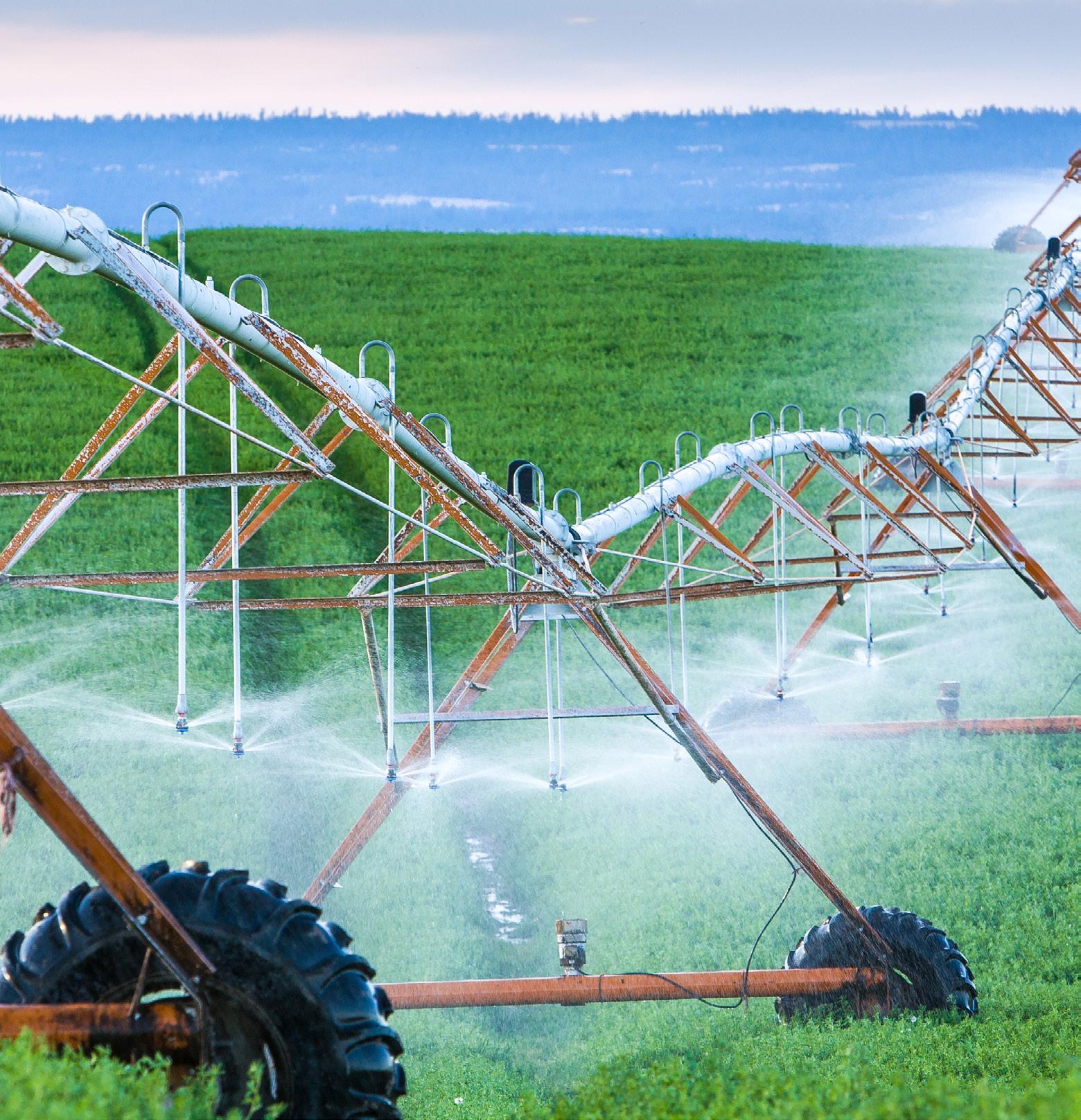
Water and food security have become priority national policy issues on the back of record drought periods in Australia, as well as disruption to supply chains through COVID-19 and recent flooding events. The ability to meet increased demand for fresh Australian produce from Far North Queensland is at major risk due to the lack of a long-term water implementation strategy. Agricultural exports are vital to FNQ with the industry sector output currently valued at $2bn1, constrained mainly by factors such as irrigation and access to market. Urban demand also continues to increase with Cairns’ population growth averaging 1.9% per annum over the past 10 years2. This, combined with a long-running history of three million tourists visiting FNQ annually, means an effective and multi-faceted water supply strategy is required to ensure the growing needs of the region can be met.
Regional Development Australia (RDA) Tropical North has completed a detailed business case for development of the Lakeland Area as a significant irrigated agricultural area. The business case was funded from a $10m grant under the National Water Infrastructure Development Fund (NWIDF).
Expansion of the currently irrigated 1,800ha area is limited due to a lack of adequate and reliable water. The preferred project includes a 296,000ML dam to irrigate up to 10,000ha of identified high quality land, taking one percent of outflow of the Mitchell River to the Gulf of Carpentaria. The scheme will directly generate up to $382m p.a. in agricultural production with an increase of up to $213m p.a. in Gross Regional Product (GRP). The scheme would also significantly contribute to population growth and boost region wide economic productivity, with up to $300m in additional GRP.
Bilateral government support is now required to progress the development approval processes for the project, support a proponent through the detailed design stage (including funding through the National Water Grid Authority) and accelerate the review of the Mitchell River Water Resource Plan to provide for the required water.
OPPORTUNITY
OPPORTUNITY
• Contributes to food security through a significant expansion of irrigated agriculture in FNQ.
• Provides major economic opportunities to deliver transformational change to the Cape York Peninsula, addressing generational disadvantage.
• Provides a pathway to Indigenous engagement through the Western Yalanji Aboriginal Corporation and ‘on country’ presence.
• Provides opportunities for population migration to regional areas of FNQ.
The Detailed Business Case is with the Australian Government. While the capital costs are notable, implementation of the scheme in line with previous agricultural schemes with significant government contribution to construction, will make the scheme affordable and realise the substantial identified benefits.
1. Expansion of irrigated agriculture in Lakeland as part of the FNQ Regional Planning process;
2. Give serious consideration to allocating water reserves from the Palmer River to Lakeland as part of the Mitchell River Catchment Water Plan review;
3. Work with the National Water Grid Authority, to seek and approve suitable infrastructure to facilitate the Lakeland Irrigation Area Scheme
4. Work with Cook Shire Council to identify suitable infrastructure and planning framework for development of the Lakeland area; and
5. Establishment of senior Queensland Government crossdepartmental Mobilisation Taskforce to progress preliminary requirements for expanded agriculture in Lakeland including working alongside Traditional Owners to understand aspirations, social infrastructure needs, and to address land tenure issues.
1. economy.id, Total exports by industry sector - FNQROC, https://economy.id.com. au/fnqroc/exports-by-industry?BMID=25
2. Cairns Regional Council, Geography & population, https://www.cairns.qld.gov.au/ experience-cairns/facts-figures-history/geography-population

Etheridge Shire Council, in conjunction with RDA Tropical North, aims to create a discrete agricultural zone through improved planning and development assessment largely within the Etheridge local government area. This includes promotion and development of the region’s agricultural and economic potential through the establishment of an agricultural and irrigation precinct in the Shire.
The project aims to establish protocols that facilitate the approval and expansion of agriculture and horticulture across the precinct on a regional basis. This will include clear delineation of areas required for environmental protection and Indigenous engagement (through Indigenous Land Use Agreements).
Up to 530,000ha of Class A and B soil is potentially available in the Shire, but there are limitations to water access and security, as well as barriers resulting from the high cost to individual farmers to achieve approvals. An estimated 495,000ML of water is available in the Gilbert River component of the Gulf Water Plan, currently under review and due to expire in November 2027.
Research is currently underway through the CRC for Developing Northern Australia (CRCNA) and the Northern Australia University Alliance as part of the Water Security for Northern Australia program, including lifting human capacity and skills in the water sector and water quality modelling and design.
An implementation strategy must also be developed and would include other key elements ranging from agreed definition of the project area to a regionwide environmental impact assessment.
A March 2022 proposal identified that $2.5m was required to develop the implementation strategy to complete the project and leverage work undertaken by CRCNA. The plan will identify the best means of accessing water and irrigating up to 50,000ha of land to diversify crop types and drive economic growth in the area.
• Unlock the full potential of this prime agricultural area to deliver an annual economic value of around $900m.
• Deliver an environmentally and culturally considered planning framework and facilitate affordable development approvals.
• Encourage secondary development and population migration to grow the regional economy.
• Establish a significant service hub situated midway between the Coral Coast and the Gulf of Carpentaria to assist in reducing cost of living and supply chain costs.
A project plan proposal has been presented to Queensland Government (through the Regional Economic Futures Fund grant). This includes an investigation into demand and likely areas of immediate take-up.
Opportunities exist for both state and federal governments to jointly fund the concept.
1. An initial $380,000 to identify the full extent of the future work required, clarify the current and latent demand, and provide a potential framework for sustainable agricultural development.
2. Commit to working with the Australian Government to establish a set of Precinct protocols as a model for this and other developments for agriculture, which could be supported by appropriate legislation to facilitate economic development.
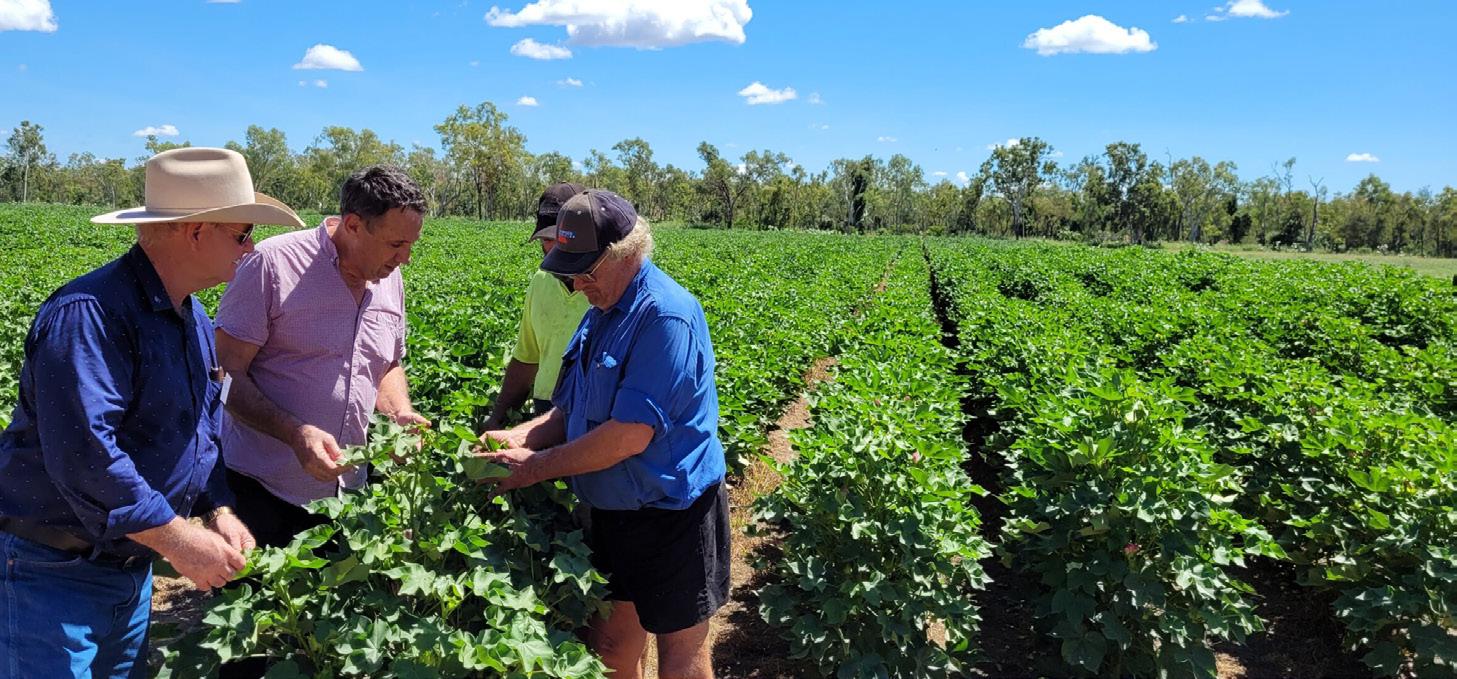
The North Johnstone diversion involves transferring water from the Johnstone River to Lake Tinaroo, redirecting unallocated water from the river to boost the water supply accessible from Tinaroo Falls Dam.
Sunwater completed a preliminary feasibility study in early 2020 indicating the diversion could deliver up 50,000ML annually into Lake Tinaroo. In 2021 the State Government announced its $9m Regional Water Assessment Program (RWAP) for three regions, one of which was the Tablelands. The RWAP aims to set roadmaps for economic growth, building on previous water supply investigations in each region, taking a comprehensive view of local water needs and identification of gaps to be filled.
The Regional Water Assessments (RWA) will set out how infrastructure and non-infrastructure solutions can be used to maximise water supply in each area and drive economic growth.
The North Johnstone diversion was one of 113 potential water supply and security options considered by the Tablelands RWA and in July 2023 was identified as one of the key projects for action in the release of the draft RWA. While the draft recognised the North Johnstone Diversion as one of the priority projects warranting further investigation, it was not included in the short term (within two years) or medium term (2-5 years) action list.
Instead it was categorised in the long-term priorities for ‘target completion in 10 years and beyond’ with the action stating ‘review supply and demand balance and subject to outcome, initiate DBC (detailed business case) for the North Johnstone Diversion’.
Public consultation on the draft RWA closed in late July 2023. The feedback received has been incorporated into an updated Regional Water Assessment which is now before the Queensland Government for review/approval.
If the Queensland Government adopts the 10-year+ timeline as per the draft RWA, this would result in a significant delay to the project given DBCs typically take up to two years to complete, followed by the need to secure government funding and obtain environmental approvals - all before construction could ultimately begin.
With an estimated cost of $115m-$150m to produce up to 11,400ML annually1, it is imperative that the Queensland Government release the final Tablelands RWA and within that bring forward the North Johnstone DBC target timeframe to ensure current and future water demand is met, securing the agricultural output from the region.
• Expanding northern Australia’s agricultural productive capacity –this is nationally significant given the impact of drought on food and water security in southern Australia.
• Increasing northern Australia’s contribution to GDP through an increase in agricultural production.
• Diversifying northern Australia’s economic capabilities to facilitate investment and reduce reliance on tourism.
• Strengthening Australia’s international competitiveness through proximity to Asia.
The draft Tablelands RWA recommended the detailed business case for the North Johnstone Diversion be initiated on a 10-year horizon.
It is imperative that the Queensland Government revisit this timeframe, adopting a shorter-term target completion date for the detailed business case for the North Johnstone Diversion.
Commit to the release of the final Tablelands Regional Water Assessment (currently under consideration) by 30 November 2024.
Commit to adopt a medium-term target completion date (2-5 years) for the detailed business case into the North Johnstone Diversion within the Regional Water Assessment document.
